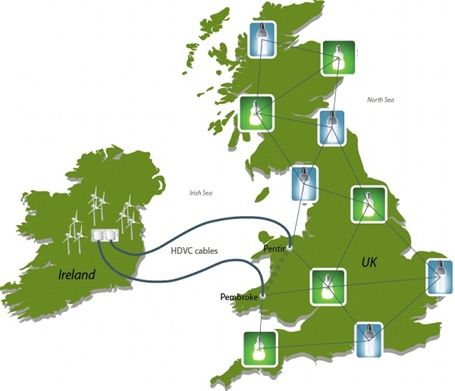Like many countries in Europe, Ireland has lofty renewable energy goals. One ambitious plan currently under discussion would feature construction of more than 700 wind turbines in central Ireland, with a capacity of 3,000 megawatts. The strange part, though, is that these turbines, built in the huge Bog of Allen, would be entirely independent of the Irish electricity grid. In fact, the entire point would be to send the power under the Irish Sea to the United Kingdom.
Element Power's proposed project, dubbed Greenwire, would cost as much as £6.5 billion ($10.4 billion). The "small clusters of onshore wind farms in the Irish Midlands" would connect to a set of redundant high-voltage direct current cables that would carry the power to two landing points in Pentir and Pembroke, both in Wales, where they would connect to the UK grid. If some financing issues involving energy subsides can be resolved, developers think the power could start flowing by 2018. They already have the grid connections in Wales secured for 2017 and 2018.
Element says the onshore turbines would save £7 billion for UK consumers compared to building an equivalent amount of wind power offshore, which is where much effort and money are being spent these days. It would also provide substantial income for Ireland, one of the countries central to the ongoing European Union debt crisis.
Ireland is also working hard to build up its own, not-for-export clean energy infrastructure. According to the Sustainable Energy Authority of Ireland's 2010-2015 strategic plan, the goal is to get half the country's power from clean sources within 15 years. Within 25 years, Ireland hopes to be totally green-powered and even be a net exporter of that clean energy, a goal that the Greenwire project would obviously support. The idea of moving renewable power around Europe has been gaining steam, including designs for an undersea grid that would connect Belgium, Denmark, France, Germany, Luxembourg, the Netherlands, Norway, the UK, and Ireland. And there seems to be a growing trend toward producing the power in a place that needs less but has more and actually using it in a country with big needs and lower capacity; the primary example is Desertec, an effort to massively build out solar installations in North Africa and ship the power to demand centers across the Mediterranean in Europe.
Ireland's wind resource is substantial, so the country of only 4.5 million people could easily end up a net exporter of power. The Greenwire project is a good first step, and building in the bogs is apparently not a problem, though they may want to look out for bog bodies.
Image via Greenwire/Element Power
Source: Spectrum

